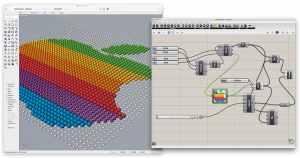One of the projects discussing computational digital fabrication is part of the MAAD program at CMU. In addition to fabrication, the program consists of architectural robotics and ecological thinking. There are multiple different studios that you can choose from in this program, but the one that interests me the most deals with experimentation with new and different materials that explore contemporary design techniques. The design process starts with using some type of algorithm to create a parametric design. Next, this can be translated into either a physical model or a 2D drawing. Some digital fabrication tools that are helpful to completing projects include 3D modeling software, robotic arms, laser cutting machines, and a CNC router.

As an architecture undergraduate student at CMU, I’m interested in any future paths I might be able to take. The importance of computational fabrication is increasing greatly in architecture schools; we are taught computational fabrication as early as the second year of the undergraduate program. For example, we had to create an object using fiberglass and resin that was designed using a computational program called Grasshopper, which works through the 3D modeling software Rhino.

![[OLD FALL 2018] 15-104 • Introduction to Computing for Creative Practice](wp-content/uploads/2020/08/stop-banner.png)